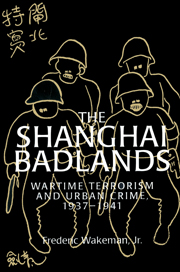Book contents
- Frontmatter
- Contents
- Dedication
- Acknowledgments
- Glossary
- Shanghai, 1940
- Metropolitan Shanghai
- Dedication
- Prologue: Consequences
- 1 Island Shanghai
- 2 Blue Shirts
- 3 National salvation
- 4 Retaliation: Pro-Japanese terrorism
- 5 Provocation: The Chen Lu assassination
- 6 Capitulation: The Xi Shitai assassination
- 7 The puppet police and 76 Jessfield Road
- 8 Terrorism and crime
- 9 Rackets
- 10 Terrorist wars
- 11 Dimout
- Epilogue: Outcomes
- Abbreviations
- Notes
- Bibliography
- Index
9 - Rackets
Published online by Cambridge University Press: 02 November 2009
- Frontmatter
- Contents
- Dedication
- Acknowledgments
- Glossary
- Shanghai, 1940
- Metropolitan Shanghai
- Dedication
- Prologue: Consequences
- 1 Island Shanghai
- 2 Blue Shirts
- 3 National salvation
- 4 Retaliation: Pro-Japanese terrorism
- 5 Provocation: The Chen Lu assassination
- 6 Capitulation: The Xi Shitai assassination
- 7 The puppet police and 76 Jessfield Road
- 8 Terrorism and crime
- 9 Rackets
- 10 Terrorist wars
- 11 Dimout
- Epilogue: Outcomes
- Abbreviations
- Notes
- Bibliography
- Index
Summary
On Saturday, February 1, 1941, Mayor Chen Gongbo and Shanghai Municipal Council Chairman W. J. Keswick had met at the Chinese city hall in Jiangwan and signed a police agreement in a blaze of flashbulbs amidst champagne toasts. The arrangement, which implemented the “modus vivendi” agreement signed a year earlier, announced regulations for the establishment of a Western Shanghai Area Special Police Force (WASP for short) or Huxi tebie jingcha zongshu to control the area next to the two concessions, the area formerly under the jurisdiction of the West Shanghai police division, a section of the jurisdiction of the Xujiahui police division, and districts presently guarded by the Shanghai foreign defense forces.
The new WASP was to be composed of the existing police main corps, the whole West Shanghai division, part of the Xujiahui division, and officers of the detective branch corps together with officers recommended by the Municipal Council. According to the regulations, it was to be the only organization to exercise police power in the above areas, and it would do so under the direction of the Shanghai city police bureau. The maximum strength was to be 1,466 men with an additional reserve of 12 men, grouped into five police divisions and a number of stations and substations. The WASP would also have seven branches: police affairs, executive, special, foreign affairs, crime, internal affairs, and a secretariat.
Officers in charge of divisions where most of the residents were foreign nationals would be appointed by the Shanghai municipal government (that is, the puppet city government) from a list of 197 candidates (including men of Chinese nationality) recommended by the Shanghai Municipal Council.
- Type
- Chapter
- Information
- The Shanghai BadlandsWartime Terrorism and Urban Crime, 1937–1941, pp. 104 - 114Publisher: Cambridge University PressPrint publication year: 1996

